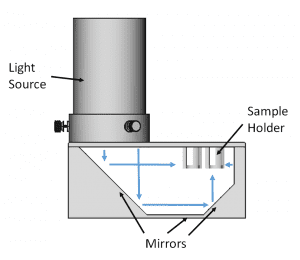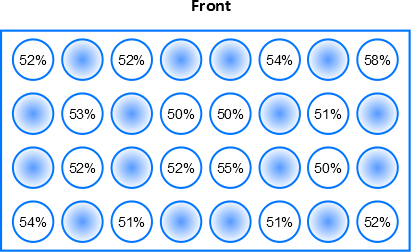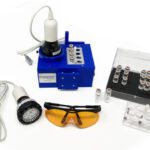However photoredox chemistry setup necessitates to the use of a light source (blue light) and apparatus that are not standard yet in an organic chemistry laboratory. Many chemists have made their own setup and tried to reproduce literature chemistry with more or less success. As a result the implementation of photoredox chemistry is slow and organic chemists are still hesitant to try these important new tools. Therefore, the need for a simple and robust device to perform visible-light photoredox catalysis has become increasingly important.
EvoluChem™ PhotoRedOx Box
The EvoluChem™ PhotoRedOx Box was designed with one main objective: To allow any chemist to easily perform multiple photoredox reactions in a reproducible environment. Our photochemistry device provide an even light distribution to all reaction samples allowing consistent and reproducible reactions. A cooling fan allows even temperature distribution and keeps the chamber near room temperature during long reaction runs. The device easily fits on standard stir plates, allowing for consistent stirring. Sample holders are compatible with vials ranging from 0.3 ml to 20 ml vials.
Unique Design
The PhotoRedOx Box is using a unique geometry of mirrors to irradiate multiple samples simulatanously for parallel chemistry setup while limiting the thermal effect of the light source. This design results into a compact and efficient photoredox device which can be easely set on any standard stir plate.

The removable lamp adapter allows easy switching from the standard kessil™ blue 34W LED lamp to many other light sources.
Fit multiple vial formats
Organic chemists needs to be able to use different reaction vial sizes depending on the scale and the number of the reaction to be performed. The PhotoRedox Box can virtually fit any type of vials including 0.3ml crimped vials (6 x 32mm), 2ml HPLC vials (12 x 32mm), 1DRAM (15 x 45mm), Microwave vial 2-5mL (17 x 83mm), 2DRAM (17 x 60mm) and 20ml scintillation vials (28 x 61mm). This feature allows quick and consistent scale up from screen reactions to larger scale with preset sample positions removing the guess work on sample placement distance from the light source. When using 0.3 ml vials, 32 reactions can be performed in parallel in the photochemical device. At 20 ml, two reactions can be run in duplicate.
Reproducibility
With the EvoluChem photomethylation kit, we have demonstrated the reproducibility of both the photomethylation kit and the device. Using a photomethylation of buspirone as test reaction, 16 vials spread through the 0.3 ml vial sample holder for Trial #1 results in 53% (+/-2 %) conversion. See figure. For a second trial with 16 reaction vials we observed an average conversion of 56% (+/-2 %) for the mono-methylated product.
Test reaction (Methylation)

|
Percentage of mono-methylation product by reaction vial position
Average- 53% +/-2% Reaction conditions: Each reaction vial contains Ir(dF-CF3-ppy)2(dtbpy)[PF6] (0.1 μmol), tert-butylperacetate solution (12.5 μmol) and a stir bar sealed under inert atmosphere. To each vial was added 50 μl of 0.05 M buspirone solution in 1:1 trifluoroacetic acid/acetonitrile sparged with nitrogen stream. Reaction mixture irradiated with Kessil 34 W blue LED for 18 hr using EvoluChem photochemical device. |
Ir/Ni visible-light photoredox catalysis exploration
A significant number of traditional cross-coupling reactions have been performed using photochemistry. In many cases, this involves using an Iridium photocatalyst like Ir(dF-CF3-ppy)2(dtbpy)[PF6] to activate a sluggish catalytic cycle (Ni) in the presence of a ligand and base. Many reactions conditions have been reported in the literature using a wide range of reagents. However, often these reactions are highly substrate, solvent and base specific. We describe several examples from literature that haven been modified to be performed in kit form in our PhotoRedOx box device.
Screening reaction conditions
To reduce the amount of catalysts, reagents and substrate used during reaction screening, we perform reaction condition at 5 μmol substrate in 100 μl solvent with 0.1 μmol Ir catalyst and 0.5 μmol premixed Ni-dtbbpy with 3 equiv. of base with stir in a vial capped under inert atmosphere.
C-C coupling through decarboxylation
The decarboxylative sp3-sp2 cross-coupling of amino acids and other activated carboxylic acids with aryl halides is a powerful tool for the synthesis of new organic molecules.

See Reference: Zuo, Z., et. al. Science 2014, 345, 437-440.
The success of this type of reaction relies on finding the right combination of Ir catalyst / Ni ligand, base and solvent. We performed the cross-coupling reaction between the substrates Boc-Val and 4-bromoacetophenone using 100 μl screening reaction condition as described previously. The results shows that the conversion is highly dependent on base. In this case Cs2CO3 and K3PO4 promote the reaction while DABCO and DBU do not.

C-N coupling with secondary amines
Cross-coupling reaction between halide aryl and secondary amine aliphatic amine are possible with Ir/Ni photoredox catalysis.

See reference: Corcoron, E. et. al., Science 2016, 353, 279-283.
Like decarboxylative sp3-sp2 cross-coupling, the success of this C-N cross-coupling relies on finding the right combination of Ir catalyst / Ni ligand, base and solvent. For example the cross-coupling reaction between the substrates pyrolidine and 4-bromoacetophenone (see below) is highly dependent of the used base. In that case DABCO promotes the reaction when Cs2CO3, K3PO4 and DBU don’t.

C-N coupling with aromatic amines
Cross-coupling reaction between halide aryl and aromatic amine are possible with Ir/Ni photoredox catalysis.

See reference: Oderinde, M., et. al. Angew. Chemie, 2016, 55, 13219-13223
In that case aniline and 4-bromoacetophenone are reacting in presence of DBU or DABCO.

C-N coupling with secondary and aromatic amines
With the indoline as substrate the reaction works better with K3PO4.
Results summary
Selection of base and solvent important to find condition for appropriate coupling (5 μmol per reaction /100 μL scale)
Screen Reaction 20x Scale-up
Reaction condition identified in the screen can be directly transposed to larger scale. For example the The decarboxylative sp3-sp2 cross-coupling of Boc-Val and 4-bromoacetophenone can be scaled up from 5 μmol to 100 μmol with 90% conversion.
 Experimental Details: In duplicate in a 4-ml vial equipped with a teflon septa and 2×7 mm stir bar, were weighed NiCl2-dme (2.2 mg, 10 μmol, 0.1 mol %), dtbbpy (2.68 mg, 10 μmol, 0.1 mol %), Ir(dF-CF3-ppy)2(dtbpy) (2.24 mg, 2 μmol, 0.02 mol %), and Cs2CO3 (97.8 mg, 300 μmol, 3 equiv.). To this vial was added a 2.0 ml solution in DMF containing Boc-Val-OH (10.85 mg, 100 μmol, 1 equiv.) and 4-bromoacetophenone (9.95 mg, 100 μmol, 1 equiv.). The solution was sparged with nitrogen via submerged needle for 5 minutes and vial was placed in EvoluChem PhotoRedOx Box with blue Kessil LED and irradiated for 24 hrs. Reaction progress was monitored by LC-MS. After 24 hours, conversion was greater than 90%. No additional product was observed at 48 hrs.
Experimental Details: In duplicate in a 4-ml vial equipped with a teflon septa and 2×7 mm stir bar, were weighed NiCl2-dme (2.2 mg, 10 μmol, 0.1 mol %), dtbbpy (2.68 mg, 10 μmol, 0.1 mol %), Ir(dF-CF3-ppy)2(dtbpy) (2.24 mg, 2 μmol, 0.02 mol %), and Cs2CO3 (97.8 mg, 300 μmol, 3 equiv.). To this vial was added a 2.0 ml solution in DMF containing Boc-Val-OH (10.85 mg, 100 μmol, 1 equiv.) and 4-bromoacetophenone (9.95 mg, 100 μmol, 1 equiv.). The solution was sparged with nitrogen via submerged needle for 5 minutes and vial was placed in EvoluChem PhotoRedOx Box with blue Kessil LED and irradiated for 24 hrs. Reaction progress was monitored by LC-MS. After 24 hours, conversion was greater than 90%. No additional product was observed at 48 hrs.
Iridium/Nickel Photoredox Kits
In order to facilitate the screening of common photochemistry reactions, EvoluChem has released a series of kits combining common Iridium, nickel, ligand and base combinations to achieve the following transformations.
Ir/Ni base and solvent screen kit: HCK1009-01-002
This kit is designed to screen reaction conditions with 8 different bases, Iridium catalyst Ir(dF-CF3-ppy)2(dtbbpy)[PF6] and Ni ligand dtbbpy. This is the quickest way to find which base will work with your substrates.
Kit reagent map
| Cs2CO3 | K3PO4 | K2HPO4 | KOH | Li2CO3 | K2CO3 | DABCO | DBU | |
| Solvent A |
2 sets of 8 bases per kit (16 total vials) HCK1009-01-002 |
|||||||
| Solvent B | ||||||||
Ir/Ni base and ligand screen kits:
HCK1009-01-003/ HCK1009-01-004
This kit is designed to screen both bases and Ni Ligand with Iridium catalyst Ir(dF-CF3-ppy)2(dtbbpy)[PF6].
It is recommended for difficult or complex substrates.
| Cs2CO3 | K3PO4 | K2HPO4 | K2CO3 | DABCO | DBU | |
| dtbbpy |
2 sets of 4 bases and 4 ligands per kit (32 total vials) HCK1009-01-003 |
2 sets of 6 bases and 4 ligands per kit (48 total vials) HCK1009-01-004 |
||||
| bphen | ||||||
| (MeO)2bpy | ||||||
| biox | ||||||
Ir/Ni base and Ir catalyst screen kit: HCK1009-01-005
This kit is designed to screen both bases (3) and Iridium catalysts (6) with Ni Ligand.
It is recommended for difficult or complex substrates.
| Cs2CO3 | CsF | DBU | |
| Ir(dF-CF3-ppy)2(dtbbpy)PF6 |
2 sets of 3 bases and 6 Ir catalysts per kit (36 total vials) HCK1009-01-005 |
||
| Ir(dtbbpy)(ppy)2PF6 | |||
| Ir(dF-CF3-ppy)2(bpy)PF6 | |||
| Ir(dF-ppy)3 | |||
| Ir(dmppy)2(dtbbpy)PF6 | |||
| Ir(dF-CH3-ppy)2(dtbbpy)PF6 | |||


